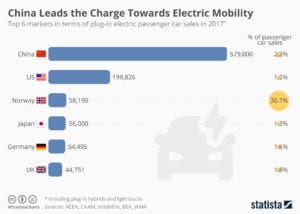Tesla may have perked interest in electric cars but clearly, China is leading sales in six global markets with 579,000 units sold in 2017. According to a Statista report written by Felix Richter, this represents but 2.3% of the country’s total passenger car sales. However, in terms of percentage, Norway topped the charts with 36.7% based on 58,000 electric cards sold last year. This market share of one electric car per three sold in Norway is significant because only Norway showed double-digit figures among the 6 countries included in the report. In terms of total numbers, the U.S posted almost 200,000 units sold or 1.2% of its automobile market. Strangely, in countries that pushed electric mobility and clean air like Japan, Germany, and the U.K., its popularity only ranged from 1.3%- 1.8%
https://www.statista.com/chart/13143/electric-vehicle-sales/
Byton, a concept car that that is the product of the collaboration of between a China car-maker and a noted European car designer made an impact at CES 2018. More astounding designs and concepts designed to curb fuel emissions were presented at the Geneva International Motor Show from March 8 -18, 2018. Electrical vehicles ranging from sedans to SUVs from Tesla, Mercedes Benz, Jaguar, Hyundai, Aston Martin, Subaru, BMW, Nissan, Chevrolet, Renault and other major names in the industry jostled for supremacy. Here are some models that could potentially unseat Tesla – which one is your favorite?
Plug-and-drive cars may be the wave of the future, and certainly for a good reason. With recent fuel-emission scandals wracking the automotive industry, attention is now focused on cars that are eco-friendly, sleek and high-performing. The EV has gone on from being a novelty to the future of transportation.
The industry is projected to grow at a rate of 72% and according to Bloomberg, 1 out of 3 cars will be an EV by 2040. Wang Chuanfu, Chairman of BYD, one of China’s leading EV manufacturers makes a daring prediction that by 2030, all cars will be electrified. Five of the major deterrents to achieving this goal are:
- poor design,
- lack of speed and compromised performance,
- lack of charging points,
- the perception of poor quality,
- and restrictions on the safety of the materials used in the production of batteries.
China is stepping up production and with a huge potential market, it is no wonder that its manufacturers, like top seller BAIC, Cherry, SAIC, and BYD are predicted to produce 4.4 million cars per year by 2020 – overtaking Tesla’s target of 1 million cars. Recognizing the limitations of Chinese-produced EVs, BYD Vice-President Stella Li says, “We’re going to design a lot of sexy, nice, cool-looking cars.”
“All over the world, people are realizing that cars that run on fossil fuels are inefficient and a major threat to the planet.”
Leonardo Di Caprio

















